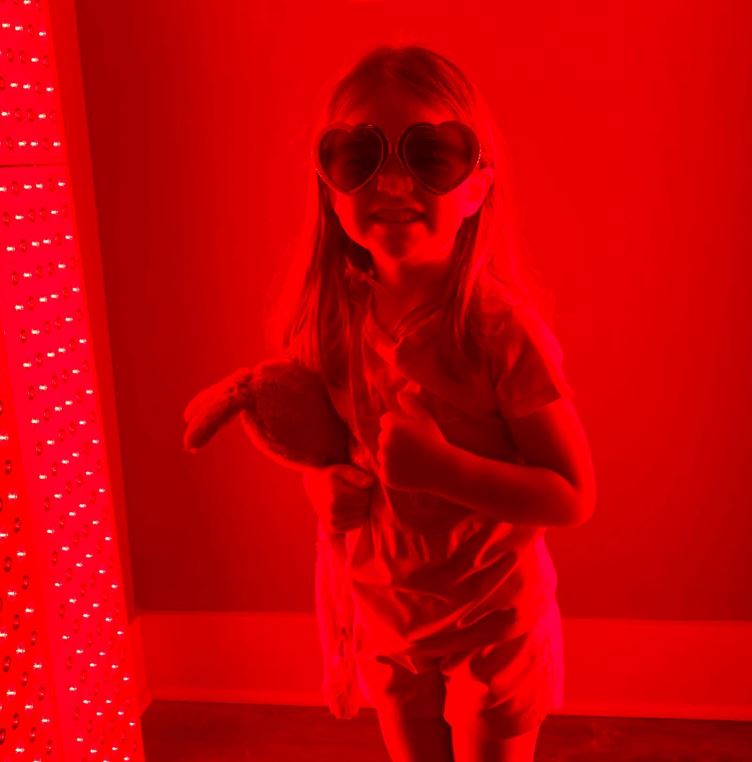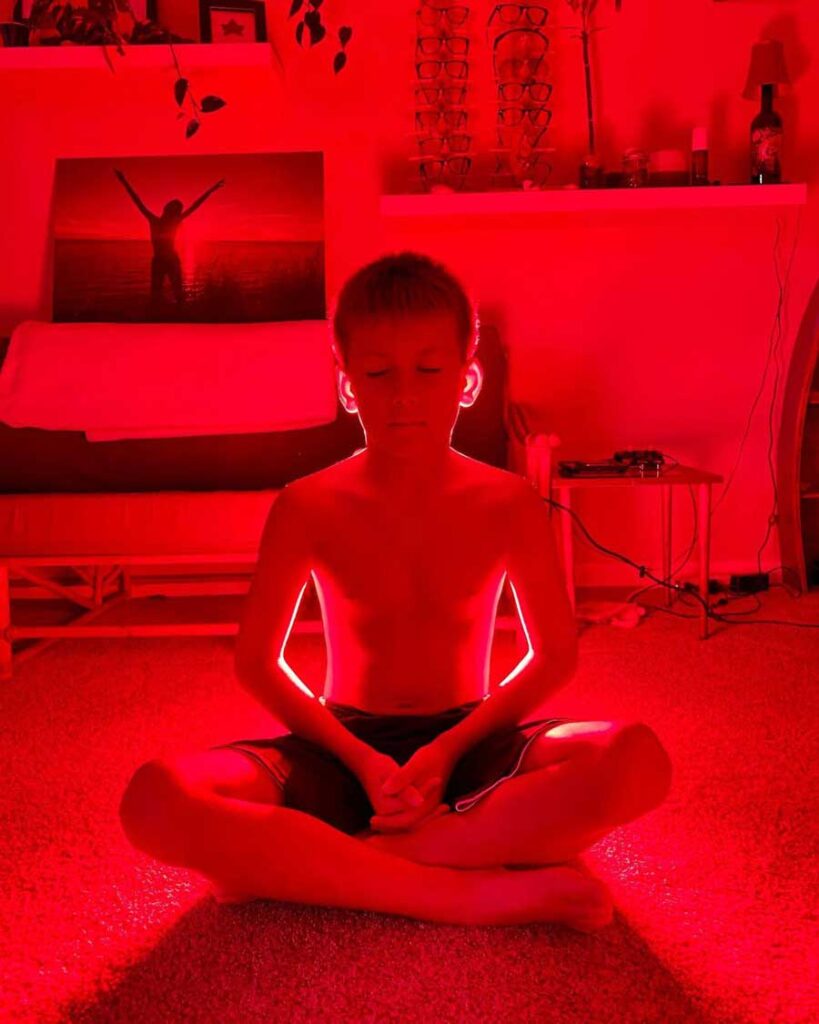![]() Free Shipping
Free Shipping ![]() Buy Now, Pay Later
Buy Now, Pay Later ![]() Eligible
Eligible
Red Light Therapy for Kids’ Eczema: A Safe and Effective Treatment?

Introduction
Eczema, also known as atopic dermatitis, is a common skin condition that affects millions of children worldwide. Characterized by dry, itchy, and inflamed skin, eczema can be both painful and frustrating for kids—and equally distressing for parents seeking relief for their little ones.
While traditional treatments like topical steroids, moisturizers, and antihistamines are commonly prescribed, many parents are now turning to red light therapy (RLT) as a natural, non-invasive alternative to manage their child’s eczema symptoms.
But does red light therapy really work for kids’ eczema? Is it safe? And how can parents incorporate it into their child’s skincare routine?
In this comprehensive guide, we’ll explore:
- What red light therapy is and how it works
- The science behind red light therapy for eczema
- Safety considerations for children
- How to use RLT at home
- Real-life success stories
- Alternative treatments and complementary therapies
By the end of this article, you’ll have a clear understanding of whether red light therapy could be the solution your child needs for healthier, happier skin.
Chapter 1: Understanding Eczema in Children
What Is Eczema?
Eczema is a chronic inflammatory skin condition that causes:
- Dry, scaly patches
- Intense itching
- Redness and swelling
- Cracked or oozing skin in severe cases
In children, eczema most commonly appears on the face, elbows, knees, and hands, though it can spread to other areas.
Why Do Kids Get Eczema?
The exact cause of eczema is unknown, but factors include:
- Genetics (family history of eczema, asthma, or allergies)
- Immune system overreaction
- Environmental triggers (dust mites, pet dander, harsh soaps)
- Food allergies (dairy, eggs, nuts)
- Stress and temperature changes
Current Treatments for Kids’ Eczema
- Topical Steroids – Reduce inflammation but may thin the skin with long-term use.
- Moisturizers – Essential for hydration but don’t address inflammation.
- Antihistamines – Help with itching but may cause drowsiness.
- Immunosuppressants – For severe cases but come with side effects.
Given these limitations, many parents seek gentler, drug-free alternatives—like red light therapy.
VELLGUS Elite V2
THE #1 RATED RED LIGHT DEVICE
VELLGUS pro V2
THE #1 RATED FULL BODY RED LIGHT DEVICE
Chapter 2: What Is Red Light Therapy?
The Basics of Red Light Therapy
Red light therapy (RLT), also known as low-level laser therapy (LLLT) or photobiomodulation, uses specific wavelengths of red and near-infrared light to stimulate healing in the body.
Unlike UV light (which damages skin), red light is safe, non-thermal, and non-invasive. It penetrates the skin to:
- Reduce inflammation
- Boost collagen production
- Enhance blood circulation
- Speed up wound healing
How Does Red Light Therapy Work for Eczema?
Research suggests RLT can help eczema by:
- Reducing Inflammation – The light calms overactive immune responses.
- Promoting Skin Repair – Increases collagen and elastin for healthier skin.
- Relieving Itching – Soothes nerve endings that cause itchiness.
- Balancing the Skin Microbiome – Helps restore good bacteria on the skin.
A 2017 study in Pediatric Dermatology found that children with eczema who used red light therapy had significant improvements in skin hydration and reduced redness compared to those who didn’t.
Chapter 3: Is Red Light Therapy Safe for Kids with Eczema?
Safety Considerations
The good news? Red light therapy is generally considered safe for children when used correctly. Unlike UV rays, it doesn’t burn or damage the skin.
However, parents should:
✔ Use FDA-cleared devices (avoid cheap, untested products)
✔ Start with short sessions (30 seconds to 2 minutes)
✔ Avoid direct eye exposure (use protective goggles)
✔ Monitor skin reactions (discontinue if irritation occurs)
When to Avoid RLT for Kids
While rare, red light therapy may not be suitable if your child has:
- Photosensitivity disorders
- Active skin infections
- Certain medications that increase light sensitivity
Always consult a pediatrician or dermatologist before starting any new treatment.
Chapter 4: How to Use Red Light Therapy for Kids’ Eczema
At-Home vs. Professional Treatments
- Professional RLT – Done in clinics with medical-grade devices (stronger, but costly).
- At-Home Devices – Portable LED panels or handheld devices (convenient and affordable).
Step-by-Step Guide for Parents
- Choose the Right Device – Look for wavelengths between 630-850nm (optimal for skin healing).
- Start Slowly – Begin with 30-second sessions, gradually increasing to 1-3 minutes per area.
- Position the Light – Hold the device 6-12 inches from the skin.
- Be Consistent – Use 3-5 times per week for best results.
- Combine with Moisturizers – Apply fragrance-free creams after treatment for added hydration.
How Long Until You See Results?
Some kids see improvements in 2-4 weeks, while others may take 6-8 weeks. Consistency is key!
Chapter 5: Real-Life Success Stories
Case Study 1: Jake’s Journey with Eczema
Jake, a 5-year-old with severe eczema, struggled with sleepless nights due to itching. After 8 weeks of red light therapy, his parents reported:
✅ 50% reduction in redness
✅ Less scratching and better sleep
✅ Fewer steroid cream applications
Case Study 2: Emma’s Clearer Skin
Emma, a 7-year-old, had stubborn eczema patches on her arms. Her mom started using a handheld RLT device daily. Within 6 weeks, her skin was smoother and less inflamed.
Chapter 6: Complementary Treatments for Eczema
While RLT can be powerful, combining it with other natural remedies enhances results:
1. Wet Wrap Therapy
- Apply moisturizer, then wrap with damp clothing to lock in hydration.
2. Probiotics
- Supports gut health, which is linked to eczema.
3. Oatmeal Baths
- Soothes itching and inflammation.
4. Coconut Oil
- Natural moisturizer with antibacterial properties.

Conclusion: Is Red Light Therapy Worth Trying for Kids’ Eczema?
Red light therapy offers a promising, drug-free option for managing kids’ eczema. With its anti-inflammatory, skin-repairing, and itch-relieving benefits, many parents find it a game-changer in their child’s skincare routine.
However, results vary, and it’s essential to:
- Consult a doctor first
- Use high-quality devices
- Stay consistent with treatments
If you’re tired of relying solely on steroids and moisturizers, red light therapy might be the gentle, effective solution your child needs for healthier skin.








